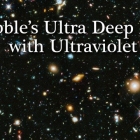"The Galaxy Star Formation Rate-Stellar Mass Correlation"
Abstract: Observation of a correlation between the star formation rate (SFR) and stellar mass (M*) of star-forming galaxies has generated a major effort to measure and model the distribution of galaxies on the SFR-M* diagram as a function of redshift. The correlation is often referred to, confusingly, as the "Galaxy Main Sequence". Starbursting galaxies lie above the correlation at temporarily-higher SFR, and galaxies lying below the correlation exhibit possibly-temporary quenching of their star formation. The amplitude of the scatter reveals the relative importance of stochasticity in galaxy formation versus the quiescent star formation traced by the average star formation history. We used Spectral Energy Distributions measured by CANDELS to find that Lyman Alpha Emitting galaxies from MUSYC lie above the correlation, whereas UV continuum-selected galaxies from the Ultraviolet Ultra Deep Field extend the correlation at z~1 down to masses as low as present-day dwarf galaxies.

